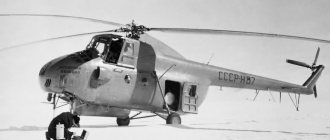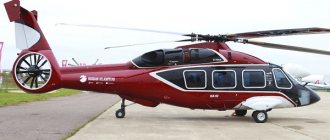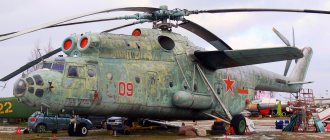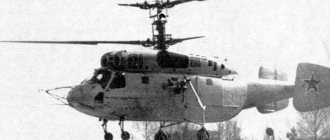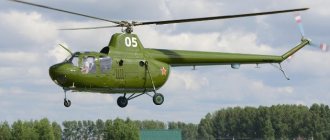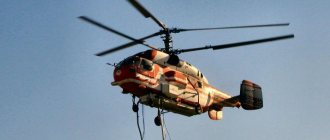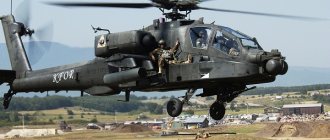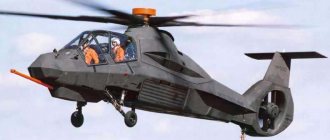| Mi-38 | |
| Mi-38 at the MAKS-2011 air show | |
| Type | medium multi-role helicopter |
| Developer | → OKB im. M. L. Mil. |
| Manufacturer | Kazan Helicopter Plant |
| First flight | December 22, 2003 |
| Start of operation | December 30, 2020 |
| Status | produced[1] |
| Operators | Russia |
| Units produced | 4 prototypes[2][3][4] |
| Development program cost | 2 billion rubles[5] |
| Unit cost | 15-17 million[6] |
| Media files on Wikimedia Commons | |
Mi-38
is a Soviet and Russian medium multi-purpose helicopter.
Serial production is carried out at the Kazan Helicopter Plant[7][8].
The Federal Air Transport Agency issued a certificate of compliance of the Mi-38 with the requirements of aviation standards[9].
History of creation[ | ]
- Design began in 1981.
- Presentation of the model at Le Bourget - 1989.
- Layout - August 1991.
- Presentation of a full-scale model at Mosaeroshow - 1992.
- Production of two prototypes began in 1993.
- Presentation of the modified model at MAKS-95 - 1995.
The Mi-38 multi-purpose helicopter can be used to transport cargo and passengers, including VIPs, and can be used as a search and rescue helicopter and a flying ambulance, for flights over land and water areas. The Mi-38 has many progressive features (in particular: a “glass cockpit” for two pilots and extensive use of composite materials, including in the main and tail rotors). The state program “Mi-38 Helicopter” is funded by the government of the Russian Federation[10].
Initial[ clear
] the propulsion system consists of two TV7-117V turboshaft engines (developed at JSC Klimov) with a take-off shaft power of 2800 hp. p. [11], previously a variant was developed with PW127TS engines [12] with a take-off power of 2500 hp. p.[13].
Several variants of the Mi-38 have been developed, including military auxiliary and special, passenger for 32 passengers, specialized cargo (with the ability to transport cargo on an external cable sling), ambulance and aerial surveillance version.
December 24, 2010 second prototype - OP-2
— the new medium civil transport and passenger helicopter Mi-38 made its first long-distance flight[14]. The Mi-38-OP-2 was equipped with PW127TS turboshaft engines, as well as a modern IBKO-38 avionics system, which implemented the “glass cockpit” concept[15].
In May 2013, the third prototype OP-3 was assembled, equipped with new Russian TV7-117V engines manufactured by the company named after. Klimova. Test flights began successfully on November 12, 2013[16][17].
The fourth prototype of the Mi-38 helicopter manufactured at the Kazan Helicopter Plant is the last pre-production aircraft of this model[18]. It made its first flight on October 16, 2014[19]. OP-4 differs from OP-3 in its impact-resistant fuel system from Aerazur and enlarged windows. During the tests OP-3 and OP-4 it is expected to obtain the final data required for certification and start of production and commercial operation of the Mi-38[20]. On October 20, 2014, OP-4 was sent for flight testing[21].
The Mi-38 helicopter will increase its speed and add new capabilities
The newest Russian multi-purpose helicopter Mi-38 will increase speed, take-off weight, and will also be able to operate in icing conditions and extreme temperatures. For this purpose, the helicopter was subjected to additional tests at the Moscow Helicopter Plant named after. M.L. Mile, during which manufacturers intend to obtain approval of major changes to the type certificate. This was reported by the Russian Helicopters holding company (part of Rostec).
The tests that have begun will significantly expand the range of tasks performed and confirm the airworthiness of various modifications of the machine. At the Kazan Helicopter it was explained that to date the tactical and technical characteristics of the Mi-38 helicopter have been achieved, which confirm the compliance of the standard helicopter design with the requirements of Russian and foreign aviation airworthiness standards.
Rotor-wing “desk” “Ansat”: forgives, but does not allow you to relax
The light Russian helicopter Ansat takes part in the flight program at the KADEX 2020 International Exhibition in Astana.
As Gazeta.Ru found out, this... → “In order to improve flight characteristics in terms of speed and load capacity, work is being carried out to make changes to the design of the helicopter, namely replacing the tail rotor, which was specially designed for the Mi-38 (previously there was an adaptive version for the Mi -28).
Changing the propeller will significantly increase the speed characteristics,” a KVZ representative told Gazeta.Ru.
Today, the Mi-38 is presented in model form at the Farnborough 2020 aerospace biennale, which opened yesterday near London. This salon is the second most popular in the industry after Le Bourget in Paris. “Russian Helicopters” notes the interest of exhibition guests in the Russian helicopter, although they do not disclose details about potential clients. Although earlier it was said about the interest of the countries of Southeast Asia, Africa, the Near and Middle East. Nevertheless
The first customer of the Mi-38 will be the Russian Ministry of Defense. As Deputy Defense Minister for Armaments Yuri Borisov previously stated, the contract for the supply of these helicopters is planned to be concluded in 2020.
Borisov noted that at this stage only the transport version is offered, but manufacturers are faced with the task of expanding the scope of use of helicopters. “Perhaps there will be a medical helicopter, there will also be a special-purpose helicopter, let’s say an electronic warfare helicopter,” said the deputy head of the Ministry of Defense.
Monitoring of US missile defense is postponed
As Gazeta.Ru learned, the delivery date for the newest serial reconnaissance ship for tracking the American missile defense system, Ivan Khurs, will be postponed to... →
The scope of the transport Mi-38 can be expanded through the creation of specialized versions, including an Arctic version. The military department and manufacturers agreed to jointly conduct flight tests of a new version of the Mi-38 for the needs of the Ministry of Defense.
The Mi-38 is assembled from Russian-made units and components. (United Engine Corporation) created the TV7-117V turboshaft engine for the helicopter, which received an international certificate at the Moscow aerospace salon MAKS-2015. Thanks to the domestic power plant, it was possible to eliminate dependence on foreign suppliers of components, including Ukrainian engine manufacturers.
According to manufacturers' estimates, TV7-117V provides a high level of safety and comfort standards, and is also among the world's best examples of this class in terms of efficiency and reliability.
The helicopter is also equipped with an integrated complex of on-board equipment IBKO-38, which provides the crew with information for safe flight operations day and night in various climatic conditions. The equipment complex allows automatic flight along the route, landing, hovering and stabilization in various flight modes.
Composite materials are widely used in the design of the Mi-38, including in the main and tail rotors. All blades are equipped with an electric anti-icing system and a damage sensor.
The Mi-38 can be used to transport cargo and passengers, carry out search and rescue operations, and serve as a flying hospital.
We set our sights on the record
The demonstration helicopter, with the help of which Russian designers want to achieve unprecedented speeds, has taken off.
Experts doubt that... → According to helicopter manufacturers, at the next stage it is planned to develop passenger and offshore versions of the Mi-38 and certify it under category A, which implies compliance with the strict requirements of international aviation standards regarding the transportation of passengers. In the passenger version, the Mi-38 can carry 29 passengers and a flight attendant. Flight performance characteristics and the ability to provide increased comfort in the cabin allow the helicopter to be used for corporate and VIP transportation. In addition, the Mi-38 will be able to operate in maritime climates, tropics and arctic conditions.
Let us recall that earlier the Russian Ministry of Industry and Trade allocated over 1 billion rubles for modifications to the Mi-38. In accordance with the tender documentation, the total volume of deliveries by 2025 was to be 175 helicopters, and by 2030 - 264 units. As KVZ director Vadim Ligai noted, the cost of preparing for serial production of the Mi-38 helicopter amounted to about 7.5 billion rubles.
Construction[ | ]
The Mi-38 is made according to the classical design with a 6-bladed main rotor with a controlled pitch, a 4-bladed X-shaped tail rotor (first used on the Mi-28) and a controlled stabilizer; the blades are made of fiberglass by winding, and their service life is practically indestructible limited. Screw hub with elastomeric bearings. The semi-monocoque fuselage is made of duralumin, non-power elements are made of 3-layer composite panels (nose cone, upper panel of the cockpit, engine cowlings, upper ramp door and keel beam fairing). The installed composite blades do not require replacement during the entire service life of the helicopter, unlike the metal blades of the Mi-8, the direct ancestor of the Mi-38[22].
In the nose, under the radio-transparent fairing, there is a weather radar. The helicopter's chassis is energy-absorbing; when falling from a height of 15 m, fuel fire is excluded.
The location of two engines behind the gearbox made it possible to improve the aerodynamics and flight performance of the helicopter.
The dimensions of the cargo compartment have been significantly increased: length is 8.7 m, width 2.34 m, height 1.82 m, volume 29.5 m³. The Mi-38 is capable of carrying up to 5 tons of cargo inside the cabin and up to 6 tons on an external sling. On a helicopter, cargo is loaded using a ramp. The side doors are sliding, and a winch with a lifting capacity of 300 kg is installed on the starboard side.
Rostec presented the first production Mi-38 at MAKS
Photo: Russian Helicopters
The Russian Helicopters holding company, part of the Rostec State Corporation, presented the first production Mi-38 helicopter with a luxury cabin at the MAKS-2019 aerospace salon.
The Mi-38, manufactured at the Kazan Helicopter Plant, will be presented at a static exhibition, and will also take part in the flight program of the air show, performing a flyby as part of the civil line of Russian Helicopters. Previously, prototypes of the Mi-38 that participated in the flight certification test program were demonstrated at the MAKS air show. In addition, the airborne transport Mi-38T, created on the basis of the certified civilian Mi-38, will make its debut in the flight program of the exhibition.
The design of the Mi-38 has a number of innovations - these are improved aerodynamic contours of the fuselage and power plant cowlings, rotor hub fairings and swashplate. Instead of the traditional placement of engines in front of the main gearbox, a scheme has been implemented with their “rear” location. This made it possible to reduce aerodynamic drag and noise levels in the cabin, as well as increase the safety of the vehicle.
“The Mi-38 is a new step in the domestic helicopter industry. The balance of its flight characteristics, efficiency parameters, flight range and cargo transportation capabilities make this helicopter extremely interesting both from the point of view of commercial operation and for government customers. At the moment, certification tests of the Mi-38 with a luxury cabin have been completed, and we are ready to begin deliveries of such machines - negotiations are currently underway with one of the leasing companies,” said Andrey Boginsky, General Director of the Russian Helicopters holding company.
In the passenger version, the Mi-38 can carry up to 30 passengers or up to 8 passengers when equipped with a luxury cabin. The flight range of the new helicopter with additional fuel tanks is up to 1,300 km. With a maximum take-off weight of 15.6 tons, the Mi-38 is capable of carrying 5 tons of payload on board or on an external sling.
The Mi-38 can be operated in a wide range of climatic conditions, including maritime, tropical and cold climates. Thanks to the technical solutions used, the helicopter surpasses other machines in its class in terms of payload, passenger capacity and basic flight characteristics.
Modifications[ | ]
Mi-38T transport and landing helicopter
, created on the instructions of the Russian Ministry of Defense, made its first flight on November 3, 2020. It has differences compared to the basic Mi-38: it is assembled entirely from Russian-made components (TV7-117V engines), additional landing gear supports have been created for landing on soft ground and snow, the fuel system is protected from explosion, additional tanks to increase the flight range; It also has an integrated digital flight and navigation system with indication on five LCD displays, which allows even one pilot to fly the helicopter, the latest satellite communication systems and special communications equipment.[23] So far, the contract with the Ministry of Defense has been concluded for two vehicles, but in the future it is planned to begin serial deliveries.
History of creation and production
- Start of design - 1981
- Presentation of the model at Le Bourget - 1989
- Layout - August 1991
- Presentation of a full-scale model at Mosaeroshow - 1992.
- Production of two prototypes began in 1993.
- Presentation of the modified model at MAKS-95 - 1995.
The Mi-38 multi-purpose helicopter can be used to transport cargo and passengers, including VIPs, and can be used as a search and rescue helicopter and a flying ambulance, for flights over land and water areas. The Mi-38 has many progressive features (in particular: a “glass cockpit” for two pilots and extensive use of composite materials, including in the main and tail rotors).
The initial propulsion system consists of two TV7-117V turboshaft engines (developed at JSC Klimov) with a take-off shaft power of 2800 hp. p. [11], previously a variant was developed with PW127TS engines [12] with a take-off power of 2500 hp. p.[13].
Several variants of the Mi-38 have been developed, including military auxiliary and special, passenger for 32 passengers, specialized cargo (with the ability to transport cargo on an external cable sling), ambulance and aerial surveillance version.
On December 24, 2010, the second prototype - OP-2 - of the new medium civil transport and passenger helicopter Mi-38 made its first long-distance flight. The Mi-38-OP-2 helicopter is equipped with PW127TS turboshaft engines, as well as a modern IBKO-38 avionics complex, which implements the “glass cockpit” concept.[14]
The installed composite blades do not require replacement during the entire service life of the helicopter, unlike the metal blades of the Mi-8, the direct ancestor of the Mi-38.[15]
In May 2013, the third prototype OP-3 was assembled, equipped with new Russian TV7-117V engines manufactured by the company named after. Klimova. Test flights began successfully on November 12, 2013[16][17].
The fourth prototype of the Mi-38 helicopter manufactured at the Kazan Helicopter Plant is the last pre-production aircraft of this model.[18] It made its first flight on October 16, 2014.[19] OP-4 differs from OP-3 in its impact-resistant fuel system from Aerazur and enlarged windows. During the tests OP-3 and OP-4 it is expected to obtain the final data required for certification and start of production and commercial operation of the Mi-38.[20] On October 20, 2014, OP-4 was sent for flight testing.[21]
The start of serial production of the Mi-38 helicopter in Kazan was planned for 2020.[22][23] At the beginning of 2020, mass production of helicopters had not yet begun. The Kazan Helicopter Plant is actively preparing for serial production of the Mi-38; the fuselage of the first production Mi-38 has been laid.[24] In August 2020, at MAKS 2015, a contract was signed with the United Engine Corporation for the supply of 50 TV7-117V engines by 2020 (for 25 vehicles, two engines per unit).[25]
The certificate for the standard design of the Mi-38 medium transport helicopter was issued by the Federal Air Transport Agency on December 30, 2020. It is expected that the passenger version of the helicopter will be certified in 2020, and in the future modifications for search and rescue and offshore operations will be created and certified.[26]
On January 10, 2020, it was announced the launch of serial production of the Mi-38 helicopter at the Kazan Helicopter Plant.[27]
Production[ | ]
The start of serial production[24] of the Mi-38 helicopter in Kazan, at the Kazan Helicopter Plant, was planned for 2020[25][26]; At the end of 2014, active preparations for production were underway, the fuselage of the first production Mi-38 was laid down[27]. In August 2020, at MAKS 2015, a contract was signed with UEC for the supply of 50 TV7-117V engines until 2020 (for 25 vehicles, two engines per unit)[28]. However, at the beginning of 2020, mass production of helicopters had not yet begun.
The certificate for the standard design of the Mi-38 medium transport helicopter was issued by the Federal Air Transport Agency on December 30, 2020. It is expected that the passenger version of the helicopter will be certified in 2020, and in the future modifications for search and rescue and offshore operations will be created and certified[29].
On January 10, 2020, it was announced the launch of serial production of the Mi-38 helicopter at the Kazan Helicopter Manufacturing Plant[8].
On December 2, 2020, the first copy of the Mi-38T was announced to be transferred to the Ministry of Defense of the Russian Federation[30], and on December 31 the second vehicle was delivered[31]. In total, the order provides for the construction of 15 helicopters.
Long way to the sky: Mi-38 helicopter
By the end of June 2020, the first serial military transport helicopter Mi-38T should arrive in service. This was stated by the General Director of Russian Helicopters OJSC Andrei Boginsky. This means that the long-term epic with the launch of the Mi-38 into serial production is finally over: if the Russian Ministry of Defense has begun purchasing these machines, then there is no need to worry about their future.
Alexander Plekhanov
February 26, 2020 11:59
The fate of the Mi-38, like all aircraft of the post-Soviet era without exception, was not easy. It took the helicopter more than thirty years to reach serial production, setting another world anti-record. Its development began in the mid-eighties of the last century, the drawings were ready in 1987, and in 1989 the model was presented at the aerospace show in Le Bourget, France. It seemed that it would take no more than two or three years before launching into series, as was the case in the USSR with other helicopter models, but the Soviet Union disappeared, and only in 1993 in Kazan were they able to somehow begin the construction of two prototypes.
It was planned that the Mi-38 would become the successor to the veteran Mi-8, the production of which began back in 1962. But during the development of the new product, it was decided to create a larger helicopter, which would have to exceed the Mi-8 in service life and 1.7 times in fuel efficiency. Composite materials and new avionics made it possible to create a machine that is in many ways superior to the Mi-8. If not for a series of sad circumstances, by the beginning of the new century Russia could have received a modern and competitive multi-purpose helicopter, occupying a niche between the Mi-8 and Mi-26.
They wanted to start serial production in 1996, and the need of the army and civilian customers was initially estimated at a thousand vehicles. Then the plans were adjusted: the Mi-38 was supposed to go into production in 1999, and the initial production run was cut almost in half. The chronic lack of funding for the aviation industry made its own negative adjustments, and only in 2003 the first experimental Mi-38 took off. His trials progressed at a truly snail's pace, stretching out for almost 15 years. In 2020, the helicopter received an airworthiness certificate, and the first production version began to be assembled only in January 2020 at the Kazan Aviation Plant.
The engines on the Mi-38 were changed twice. Initially, they decided to equip the helicopter with TVA-3000 gas turbine engines with a total power of 5000 hp, then they were replaced with Pratt & Whitney engines, but the machine went into production with Russian TV7-117V gas turbine engines produced by Klimov OJSC.
The Mi-38 weighs 15,600 kg and can carry up to six tons of cargo, versus four tons for the Mi-8. In the passenger version, the cabin of the new model is equipped with 32 seats, a buffet, a toilet and a wardrobe. In the VIP version, the helicopter is designed to carry eight passengers and four crew members, including two flight attendants. The sanitary modification is capable of transporting six patients on stretchers and four doctors. The composite main rotor does not require replacement throughout its entire service life, the “glass cockpit” has made it possible to reduce the number of crew members to two people, the helicopter is controlled by three independent hydraulic systems: the machine will be able to fly and land even if two of them fail, and maneuvers on one engine in case of failure of the second.
The Mi-38 has a maximum speed of 300 km/h, and at cruising speed of 285 km/h it is capable of flying 1,200 kilometers. The undoubted advantages include the possibility of hangar-free storage and an effective anti-icing system. Like the Mi-8, the new aircraft can be operated in harsh weather conditions, is unpretentious, and thanks to some maintenance-free components, its service will not cause serious problems for operators.
World records[ | ]
- At the XIV Helicopter Sports Championship, held from August 22 to 26, 2012 at the Drakino airfield near Moscow, test pilots of the Moscow Helicopter Plant named after. Mil on the Mi-38 overcame the altitude bar of 8600 meters and set a new world flight altitude record for helicopters, as well as a record for rate of climb without load to a height of 3000 m in 6 minutes in the E-1h class (FAI category for helicopters with take-off weight from 10 to 20 tons)[32]. The record was broken on August 15, 2013 by a Mi-8MSB helicopter with TV3-117VMA-SBM1V 4E series engines, which rose to a height of 9150 meters[33].
- September 10, 2012 at the airfield of OJSC Moscow Helicopter Plant named after. M. L. Mil Mi-38 set a record for lifting a commercial cargo of 1000 kg to a height of 8000 m. Crew: Alexander Klimov (crew commander), Salavat Sadriev (co-pilot), Sergei Seryogin (navigator), Igor Klevantsev (lead engineer) [34].
- Record for lifting a load of 2000 kg to a height of 7020 m. Crew: Salavat Sadriev (crew commander), Vladimir Kutanin (co-pilot), Sergei Seregin (navigator), Nikolai Solovyov (lead engineer)[34].
Specifications[ | ]
Mi-38 at the MAKS-2005 air show Mi-38 at the MAKS-2005 air show
- Crew: 2 people
- Passengers: 30 people. (step 75 cm)
Dimensions[ | ]
- Main rotor diameter: 21.1 m
- Tail rotor diameter: 3.84 m
- Length with rotation screws: 25 m
- Fuselage length: 19.95 m
- Fuselage width: 4.5 m
- Height with rotation screws: 6.98 m
Interior dimensions
- Length: 8700 mm
- Width: 2340 mm
- Height: 1800 mm
- Volume: 29.5 m³[35]
Mass[ | ]
- Empty: 9200 kg
- Normal takeoff: 14200 kg
- Max. take-off: 15600 kg
- Max. external payload: 6000 kg
- Max. payload in transport cabin: 5000 kg
Powerplant[ | ]
- Engines TV7-117V
- Takeoff power: 2 × 2800 l. p.[36]
- Power in emergency mode (30 sec.): 2 × 3750 l. p.[36]
At the initial stage, the possibility of installing a foreign-made engine from Pratt & Whitney was also considered, but after the conflict with Georgia, the United States imposed a ban on its installation due to the possible dual use of Mi-38 helicopters.
Flight performance[ | ]
- Cruising speed: 260-280 km/h
- Maximum speed: 300 km/h
- Ferry range: 1350 km
- Practical range: 820 km
- Dynamic ceiling: 6300 m
- The maximum rise to a height of 8620 meters without load.
- Maximum lift to a height of 7895 meters with a load of 1 ton.
- Maximum lift to a height of 7020 meters with a load of 2 tons.
